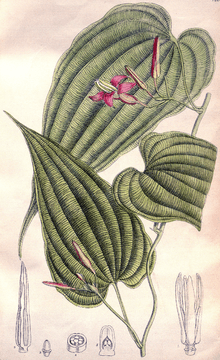Stemona
Stemona is a genus of vines and subshrubs in the family Stemonaceae, described as a genus in 1790.[3][4]
| Stemona | |
|---|---|
 | |
| Stemona curtisii[1] | |
| Stemona japonica | |
| Scientific classification | |
| Kingdom: | Plantae |
| Clade: | Tracheophytes |
| Clade: | Angiosperms |
| Clade: | Monocots |
| Order: | Pandanales |
| Family: | Stemonaceae |
| Genus: | Stemona Lour. |
| Synonyms[2] | |
| |
Stemona is native to China, the Indian Subcontinent, Southeast Asia, Papuasia, and northern Australia.[2][5]
Species
- S. angusta I.Telford - Qld
- S. aphylla Craib - Thailand
- S. australiana (Benth.) C.H.Wright NG, NT, WA, Qld
- S. burkillii Prain - Thailand, Myanmar
- S. cochinchinensis Gagnep. - Vietnam
- S. collinsiae Craib - Thailand, Vietnam
- S. curtisii Hook.f. - Sri Lanka, Nicobar, Thailand, Lepar
- S. griffithiana Kurz - Myanmar
- S. hutanguriana Chuakul - Thailand
- S. involuta Inthachub - Thailand
- S. japonica (Blume) Miquel - SE China, Japan
- S. javanica (Kunth) Engl. - Java, Maluku, Bismarck, NG
- S. kerrii Craib - Yunnan, Thailand, Vietnam
- S. kurzii Prain - Myanmar
- S. lucida (R.Br.) Duyfjes - Qld, NG, Philippines
- S. mairei (H.Léveillé) K.Krause - Sichuan, Yunnan
- S. parviflora C.H.Wright - Hainan
- S. phyllantha Gagnep. - Thailand
- S. pierrei Gagnep. - Vietnam, Laos
- S. prostrata I.Telford - NT
- S. temona rupestris Inthachub - Thailand
- S. sessilifolia (Miq.) Miq. - SE China
- S. squamigera Gagnep. - Laos
- S. tuberosa Lour. - China, Indian Subcontinent, SE Asia, New Guinea
Fossil record
2 fossil seeds of †Stemona germanica from the early Miocene, have been found in the Kristina Mine at Hrádek nad Nisou in North Bohemia, the Czech Republic. Fossil seeds of Stemona germanica have also been recorded from the nearby Hartau in Germany. Stemona fossil seeds are recorded from many European sites ranging in ages from the Maastrichtian to the Late Miocene.[6]
Cultivation and uses
Stemona tuberosa (Chinese: 百部; pinyin: bǎi bù), is one of the 50 fundamental herbs used in traditional Chinese medicine.
gollark: That seems plausible, or at least the most plausible result after [REDACTED] retrocausal alteration I guesßs.
gollark: Oh, so apiohazard predated apioform?
gollark: Teleporting or backward-going, that is.
gollark: Teleporting buses *would* be worrying and *could* necessitate Contingency MILLIMETRE EDIFICATION, the dismantling of the UK's public transport systems before the anomaly could spread.
gollark: <@!160279332454006795> HELP I ACCIDENTALYL SAVED A LOW RESOLUTION VERSION ÅAAAAAAAAAA
References
- 1892 illustration by J.N. Fitch (d. 1927) - Curtis's Botanical Magazine v.118 [ser. 3:v.48] (1892)
- Kew World Checklist of Selected Plant Families
- Loureiro, João de. 1790. Flora cochinchinensis : sistens plantas in regno Cochinchina nascentes. Quibus accedunt aliae observatae in Sinensi imperio, Africa Orientali, Indiaeque locis variis. Omnes dispositae secundum systema sexuale Linnaeanum 2: 401, 404 in Latin
- Tropicos, Stemona Lour.
- Flora of China Vol. 24 Page 70 百部属 bai bu shu Stemona Loureiro, Fl. Cochinch. 2: 401, 404. 1790.
- A review of the early Miocene Mastixioid flora of the Kristina Mine at Hrádek nad Nisou in North Bohemia, The Czech Republic, January 2012 by F. Holý, Z. Kvaček and Vasilis Teodoridis - ACTA MUSEI NATIONALIS PRAGAE Series B – Historia Naturalis • vol. 68 • 2012 • no. 3–4 • pp. 53–118
External links
- "Stemona Lour". Australian Plant Name Index (APNI), IBIS database. Centre for Plant Biodiversity Research, Australian Government.
- Germplasm Resources Information Network: Stemona
This article is issued from Wikipedia. The text is licensed under Creative Commons - Attribution - Sharealike. Additional terms may apply for the media files.